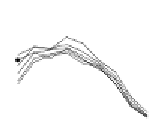Environmental Engineering Reference
In-Depth Information
respectively (Figure 3). Generally, the ground temperature decreased with the increase of soil
depth, and the deep soil temperature showed little difference.
air tempereture
0cm
5cm
10cm
15cm
20cm
50
Bare land
T. chinensis
S. s
a
lsa
P. australis
40
30
20
10
0
Month
Figure 3. Annual variations of air and soil temperature.
No significant difference of soil water content was found among the four sites (Figure 4),
but the deep soil moisture is obviously higher than that of the topsoil (Figure 4). Owing to the
P. australis community were
flooded in August, we did not measure soil moisture.
5cm
10cm
15cm
0cm
60
Bare land
T. chinensis
S. glauca
P. australis
50
40
30
20
10
0
Month
Figure 4. Annual variations of soil moisture at different soil depths.
Due to the bare land salinity is beyond the scope of the conductivity meter, no bare land
conductivity data was showed in figure 5. The EC of the
P. australis community were
lower
than that of the others. The figure exhibited single- nadir curves, with the nadir at August,
because of eluviations of the heavy rainfall.
15cm
10cm
0cm
5cm
22
S. gla
u
ca
T. chinensis
P
. australis
20
18
16
14
12
10
8
6
Month
Figure 5. Annual variation of soil electric conductivity at different soil depths.
TC
、
TN
、
NH
4
+
-N and NO
3
—
N of soil surface (0~10cm) were generally higher than
those in subsurface sediment (10~20cm). The values of TC and TN followed the order:
P.
australis
>
S. glauca
>
T. chinensis
>bare land. And the maximum and minimum value of
NH
4
+
-N and NO
3
—
N both appeared in May and August.



































































































































































































































































































































































































































































































































































































































































































































































































































































































































































































































































































































































































































































































































































